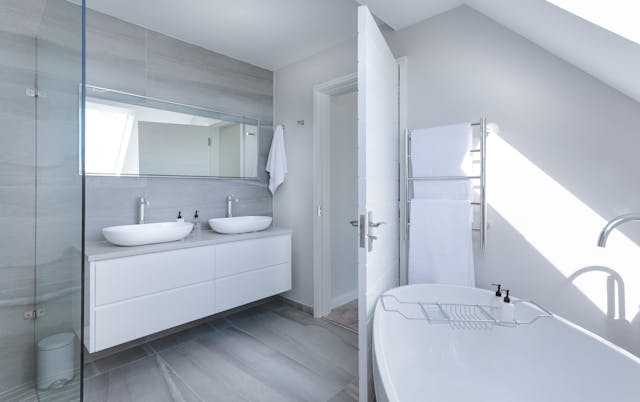Choosing the right bath for your home is a decision that balances aesthetics, functionality, and personal preference. The primary types to consider are built-in and freestanding baths, each offering unique benefits and considerations. Here’s a comprehensive guide to help you decide which is best for your space.
Built-In Baths
Advantages
1. Space Efficiency: Built-in baths are ideal for smaller bathrooms as they are designed to fit snugly against one or two walls. This positioning maximizes floor space and can make a bathroom feel more spacious.
2. Storage Opportunities: The installation of built-in baths often includes the option to integrate storage solutions. Surrounding walls can be equipped with shelves, ledges, or even cabinets to keep bathroom essentials within easy reach.
3. Cost-Effectiveness: Typically, built-in baths are less expensive to purchase and install. They require fewer materials for installation and generally involve simpler plumbing work.
4. Easy Cleaning: With three sides usually enclosed, built-in baths are easier to clean around. There are fewer exposed surfaces, reducing the accumulation of dust and grime.
Considerations
1. Design Limitations: Built-in baths offer less flexibility in terms of design and placement. They often come in standard shapes and sizes, which might limit creativity in bathroom design. You can work with a designer bathroom shop in St Albans to make sure you use your space to its full advantage.
2. Installation Complexity: While they are generally easier to install than freestanding baths, built-in models still require precise fitting, sealing, and, often, tile work. This can be complex, especially in older homes with uneven walls and floors.
Freestanding Baths
Advantages
1. Aesthetic Appeal: Freestanding baths are a statement piece. They come in a variety of styles, from modern and minimalist to classic clawfoot designs, adding a touch of luxury and elegance to any bathroom.
2. Design Flexibility: These baths can be placed anywhere there is plumbing access, offering more freedom in bathroom layout. They can serve as the focal point of the room, creating a spa-like ambiance.
3. Larger Bathing Area: Freestanding baths often provide a deeper and more spacious bathing experience compared to built-in models, making them ideal for those who enjoy long, relaxing soaks.
Considerations
1. Space Requirements: Freestanding baths require more space around them to highlight their design and allow for easy access. They are less suited to smaller bathrooms where every inch counts.
2. Higher Costs: These baths are generally more expensive to purchase and install. The installation involves more complex plumbing work, and the bath itself tends to be pricier.
3. Maintenance Challenges: Cleaning around and beneath a freestanding bath can be challenging, especially in models with feet or intricate designs. Dust and dirt can accumulate in hard-to-reach places.
4. Stability and Support: Freestanding baths need a stable and level floor to ensure they sit properly. This may require additional structural support, particularly in upper-floor bathrooms.
Making the Decision
1. Assess Your Space: Consider the size and layout of your bathroom. If you have a smaller space, a built-in bath might be more practical. For larger bathrooms, a freestanding bath can become a stunning centerpiece.
2. Evaluate Your Budget: Determine your budget for both purchase and installation. Built-in baths are generally more budget-friendly, while freestanding baths require a larger investment.
3. Consider Usage: Think about how you use your bath. If you prefer quick showers and have limited time for baths, a built-in model might suffice. If you enjoy soaking and relaxing, the deeper freestanding bath could be worth the investment.
4. Style Preference: Reflect on your design preference. Built-in baths offer a streamlined look, while freestanding baths add a dramatic, luxurious touch.
In conclusion, both built-in and freestanding baths have their unique advantages and considerations. Your choice should ultimately reflect your personal style, budget, and the specific needs of your bathroom space. By carefully evaluating these factors, you can select the perfect bath that combines functionality with aesthetic appeal.
